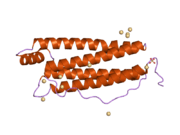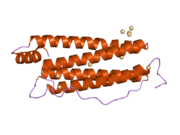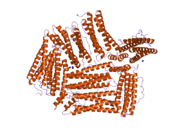Ferritin light chain
| Ferritin, light polypeptide | |||||||||||||
|---|---|---|---|---|---|---|---|---|---|---|---|---|---|
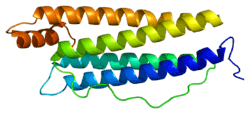 PDB rendering based on 2ffx[1]. | |||||||||||||
| |||||||||||||
| Identifiers | |||||||||||||
| Symbols | FTL ; LFTD; NBIA3 | ||||||||||||
| External IDs | OMIM: 134790 MGI: 95590 HomoloGene: 79330 GeneCards: FTL Gene | ||||||||||||
| |||||||||||||
| RNA expression pattern | |||||||||||||
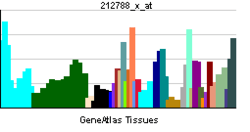 | |||||||||||||
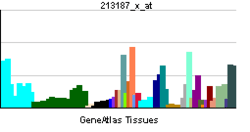 | |||||||||||||
| More reference expression data | |||||||||||||
| Orthologs | |||||||||||||
| Species | Human | Mouse | |||||||||||
| Entrez | 2512 | 14325 | |||||||||||
| Ensembl | ENSG00000087086 | ENSMUSG00000050708 | |||||||||||
| UniProt | P02792 | P29391 | |||||||||||
| RefSeq (mRNA) | NM_000146 | NM_010240 | |||||||||||
| RefSeq (protein) | NP_000137 | NP_034370 | |||||||||||
| Location (UCSC) | Chr 19: 49.47 – 49.47 Mb | Chr 13: 74.41 – 74.41 Mb | |||||||||||
| PubMed search | |||||||||||||
Ferritin light chain is a protein that in humans is encoded by the FTL gene.[2][3][4]
It is abnormally expressed in fetuses of both IVF and ICSI, which may contribute to the increase risk of birth defects in these ART.[5]
Function
This gene encodes the light subunit of the ferritin protein. Ferritin is the major intracellular iron storage protein in prokaryotes and eukaryotes. It is composed of 24 subunits of the heavy and light ferritin chains. Variation in ferritin subunit composition may affect the rates of iron uptake and release in different tissues. A major function of ferritin is the storage of iron in a soluble and nontoxic state. This gene has multiple pseudogenes.[4]
Although ferritin light chain has no ferroxidase activity, the light chain may be responsible for the electron transfer across the ferritin protein cage.[6]
Clinical significance
Defects in this light chain ferritin gene are associated with several neurodegenerative diseases and hyperferritinemia-cataract syndrome.[7]
Mutations of the FTL gene cause the rare adult-onset basal ganglia disease also known as neuroferritinopathy).[8]
Interactions
Ferritin light chain has been shown to interact with FTH1.[9][10]
See also
References
- ↑ Wang, Z.; Li, C.; Ellenburg, M.; Soistman, E.; Ruble, J.; Wright, B.; Ho, J. X.; Carter, D. C. (2006). "Structure of human ferritin L chain". Acta Crystallographica Section D Biological Crystallography 62 (7): 800–806. doi:10.1107/S0907444906018294. PMID 16790936.
- ↑ Lebo RV, Kan YW, Cheung MC, Jain SK, Drysdale J (Jan 1986). "Human ferritin light chain gene sequences mapped to several sorted chromosomes". Hum. Genet. 71 (4): 325–8. doi:10.1007/BF00388458. PMID 3000916. Check date values in:
|year= / |date= mismatch(help) - ↑ Gasparini P, Calvano S, Memeo E, Bisceglia L, Zelante L (Apr 1998). "Assignment of ferritin L gene (FTL) to human chromosome band 19q13.3 by in situ hybridization". Ann. Genet. 40 (4): 227–8. PMID 9526618. Check date values in:
|year= / |date= mismatch(help) - ↑ 4.0 4.1 "FTL ferritin, light polypeptide". National Center for Biotechnology Information. 5 July 2009. Retrieved 20 July 2009.
- ↑ Zhang Y, Zhang YL, Feng C, Wu YT, Liu AX, Sheng JZ et al. (October 2008). "Comparative proteomic analysis of human placenta derived from assisted reproductive technology". Proteomics 8 (20): 4344–56. doi:10.1002/pmic.200800294. PMID 18792929.
- ↑ Carmona U, Li L, Zhang L, Knez M (2014). "Ferritin light-chain subunits: key elements for the electron transfer across the protein cage". Chemical Communications 50 (97): 15358–15361. doi:10.1039/c4cc07996e. PMID 25348725.
- ↑ Zandman-Goddard G, Shoenfeld Y (2007). "Ferritin in autoimmune diseases". Autoimmun Rev 6 (7): 457–63. doi:10.1016/j.autrev.2007.01.016. PMID 17643933.
- ↑ Gregory A, Hayflick SJ (2011). "Genetics of neurodegeneration with brain iron accumulation". Curr Neurol Neurosci Rep 11 (3): 254–61. doi:10.1007/s11910-011-0181-3. PMID 21286947.
- ↑ Rual JF, Venkatesan K, Hao T, Hirozane-Kishikawa T, Dricot A, Li N et al. (Oct 2005). "Towards a proteome-scale map of the human protein-protein interaction network". Nature 437 (7062): 1173–8. doi:10.1038/nature04209. PMID 16189514.
- ↑ Stelzl U, Worm U, Lalowski M, Haenig C, Brembeck FH, Goehler H et al. (Sep 2005). "A human protein-protein interaction network: a resource for annotating the proteome". Cell 122 (6): 957–68. doi:10.1016/j.cell.2005.08.029. PMID 16169070.
External links
Further reading
- Munro HN, Aziz N, Leibold EA, Murray M, Rogers J, Vass JK et al. (1988). "The ferritin genes: structure, expression, and regulation". Ann. N. Y. Acad. Sci. 526: 113–23. doi:10.1111/j.1749-6632.1988.tb55497.x. PMID 3291676.
- Cazzola M, Skoda RC (June 2000). "Translational pathophysiology: a novel molecular mechanism of human disease". Blood 95 (11): 3280–8. PMID 10828006.
- Arosio P, Adelman TG, Drysdale JW (June 1978). "On ferritin heterogeneity. Further evidence for heteropolymers". J. Biol. Chem. 253 (12): 4451–8. PMID 659425.
- Gatti RA, Shaked R, Mohandas TK, Salser W (October 1987). "Human ferritin genes: chromosomal assignments and polymorphisms". Am. J. Hum. Genet. 41 (4): 654–67. PMC 1684326. PMID 2821803.
- Chou CC, Gatti RA, Fuller ML, Concannon P, Wong A, Chada S et al. (February 1986). "Structure and expression of ferritin genes in a human promyelocytic cell line that differentiates in vitro". Mol. Cell. Biol. 6 (2): 566–73. PMC 367547. PMID 3023856.
- Santoro C, Marone M, Ferrone M, Costanzo F, Colombo M, Minganti C et al. (April 1986). "Cloning of the gene coding for human L apoferritin". Nucleic Acids Res. 14 (7): 2863–76. doi:10.1093/nar/14.7.2863. PMC 339708. PMID 3754330.
- Boyd D, Vecoli C, Belcher DM, Jain SK, Drysdale JW (September 1985). "Structural and functional relationships of human ferritin H and L chains deduced from cDNA clones". J. Biol. Chem. 260 (21): 11755–61. PMID 3840162.
- Worwood M, Brook JD, Cragg SJ, Hellkuhl B, Jones BM, Perera P et al. (1985). "Assignment of human ferritin genes to chromosomes 11 and 19q13.3----19qter". Hum. Genet. 69 (4): 371–4. doi:10.1007/BF00291657. PMID 3857215.
- Dörner MH, Salfeld J, Will H, Leibold EA, Vass JK, Munro HN (May 1985). "Structure of human ferritin light subunit messenger RNA: comparison with heavy subunit message and functional implications". Proc. Natl. Acad. Sci. U.S.A. 82 (10): 3139–43. doi:10.1073/pnas.82.10.3139. PMC 397730. PMID 3858810. Vancouver style error (help)
- Caskey JH, Jones C, Miller YE, Seligman PA (January 1983). "Human ferritin gene is assigned to chromosome 19". Proc. Natl. Acad. Sci. U.S.A. 80 (2): 482–6. doi:10.1073/pnas.80.2.482. PMC 393402. PMID 6572903.
- Addison JM, Fitton JE, Lewis WG, May K, Harrison PM (November 1983). "The amino acid sequence of human liver apoferritin". FEBS Lett. 164 (1): 139–44. doi:10.1016/0014-5793(83)80037-4. PMID 6653779.
- Girelli D, Corrocher R, Bisceglia L, Olivieri O, De Franceschi L, Zelante L et al. (December 1995). "Molecular basis for the recently described hereditary hyperferritinemia-cataract syndrome: a mutation in the iron-responsive element of ferritin L-subunit gene (the "Verona mutation")". Blood 86 (11): 4050–3. PMID 7492760.
- Beaumont C, Leneuve P, Devaux I, Scoazec JY, Berthier M, Loiseau MN et al. (December 1995). "Mutation in the iron responsive element of the L ferritin mRNA in a family with dominant hyperferritinaemia and cataract". Nat. Genet. 11 (4): 444–6. doi:10.1038/ng1295-444. PMID 7493028.
- D'Agostino P, Faniello MC, Quaresima B, Bevilacqua MA, Tiano MT, Ammendola R et al. (October 1995). "Negative and positive elements in the promoter region of the human apoferritin L gene". Biochem. Biophys. Res. Commun. 215 (1): 329–37. doi:10.1006/bbrc.1995.2470. PMID 7575610.
- Rogers JT, Andriotakis JL, Lacroix L, Durmowicz GP, Kasschau KD, Bridges KR (July 1994). "Translational enhancement of H-ferritin mRNA by interleukin-1 beta acts through 5' leader sequences distinct from the iron responsive element". Nucleic Acids Res. 22 (13): 2678–86. doi:10.1093/nar/22.13.2678. PMC 308227. PMID 8041631.
- Spanner M, Weber K, Lanske B, Ihbe A, Siggelkow H, Schütze H et al. (August 1995). "The iron-binding protein ferritin is expressed in cells of the osteoblastic lineage in vitro and in vivo". Bone 17 (2): 161–5. doi:10.1016/S8756-3282(95)00176-X. PMID 8554925. Vancouver style error (help)
- Rogers JT (March 1996). "Ferritin translation by interleukin-1and interleukin-6: the role of sequences upstream of the start codons of the heavy and light subunit genes". Blood 87 (6): 2525–37. PMID 8630420.
- Pang JH, Jiang MJ, Chen YL, Wang FW, Wang DL, Chu SH et al. (May 1996). "Increased ferritin gene expression in atherosclerotic lesions". J. Clin. Invest. 97 (10): 2204–12. doi:10.1172/JCI118661. PMC 507299. PMID 8636399.
| |||||||||||||
